The joys of summer are here but one spoilsport may try to ruin some of the fun. From June through August, you may catch the Japanese beetle (Popillia japonica) eating the plants in your neighbourhood and garden. Feeding on the fruit and foliage (leaves) of over 300 species including ornamental, native and agricultural plants, this invasive beetle is by no means a picky eater.
Native to Asia, Japanese beetles arrived in the United States of America in 1916, eventually spreading and establishing a population in Southern Ontario in the late 1990’s. The hearty appetite of this small beetle continues to have negative economic, social and ecological impacts for the urban forest and beyond.
To identify the beetle, you must first understand its life cycle.
Identification and Life Cycle
The Japanese beetle spends most of its life underground only emerging from the soil as a small, one-centimeter-long adult beetle during the summer months. Adult beetles are easy to identify with their flashy metallic colouring and feeding habits. The head, abdomen and thorax (central body region) are metallic green, and the wing coverings are metallic copper-brown. Along each side of the abdomen are five distinct bright white tufts of hair.
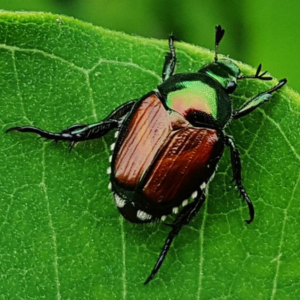
Adults prefer to get together when feeding in the months of July and August and are rarely seen alone. These beetles are skeletonizers, meaning they specialize in eating the soft green tissue of leaves. This eating technique creates a lace-like pattern of veins on the leaf giving it a brown, papery appearance.
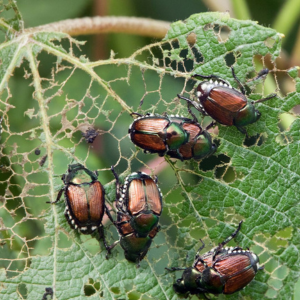
In August, mated adult females burrow into the ground to lay their eggs. One to two weeks later, eggs hatch into white, c-shaped grub larvae that begin feeding on the roots of grasses and other plants. As the cold temperatures of winter approach, the larvae dig deeper into the ground to hibernate, returning closer to the surface to feed again in the spring when temperatures warm. In June, the larvae pupate then emerge aboveground as adults in June and July.
Japanese beetles only live for one year, meaning that shortly after mating and laying eggs in August, they die. Although these beetles are around for a short time, their impact is big.
Impacts of Adult Beetles
The Japanese beetle has invaded diverse habitats including forests, urban and agricultural areas and even backyard gardens. The beetle’s far reach, coupled with the impacts of defoliation from its ravenous and broad eating habits, can have several negative impacts.
- Economic Impacts – Adult beetles feed heavily on agricultural crops including soybeans, corn and fruit trees. This feeding reduces crop yields resulting in profit losses for growers.
- Social Impacts – Heavy feeding by adult beetles depreciates the aesthetics of the trees, shrubs, perennials and annuals in our recreational areas like backyard gardens, parks and streets by tarnishing the appearance of leaves, flowers and fruit.
- Ecologic Impacts – Extensive feeding by adult beetles reduces the amount of food available to other native wildlife. It also reduces growth and creates stress in plants, which makes them less resilient. As a result, heavily defoliated plants may be more susceptible to other stressors including diseases, drought and other insect feeding.
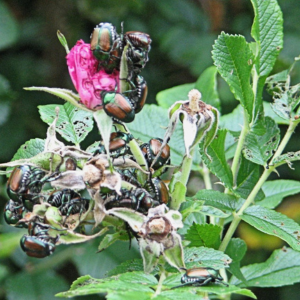
Japanese beetle grub larvae also have negative social and economic impacts. To learn more, visit the Invasive Species Centre. Now that we know a bit about the pest, how do we manage it?
Managing Adult Beetles
The Japanese beetle is an established species, which means it is unfortunately here to stay. It is difficult to predict how and where populations of the beetle will fluctuate and there is no guaranteed magic formula to completely stop them.
Although their presence is unwanted, the good news is that Japanese beetles are more of a cosmetic nuisance for homeowners. Most of the time the defoliation from feeding is not high enough to cause permanent damage, especially on established trees and shrubs. As such, it is not necessary to fully eliminate the beetles to protect our plants. This means the best management approach is to minimize its impact on our trees, shrubs and other plants.
Here are some of the recommended techniques to manage and reduce the impact of Japanese beetles in your backyard:
- Identify and Monitor Hosts – Japanese beetles target a wide variety of plants and understanding which trees, shrubs, perennials or annuals in your backyard may be a host is an important starting point. Once identified, be on the lookout for signs and symptoms of the beetle on these plants during the summer months to catch them before they start feeding in larger numbers. Defoliated plants release compounds that attract more beetles, so finding and removing beetles early will help reduce their impact.
- Remove Beetles – for smaller backyard plants including shrubs and young trees, beetles can be removed by hand. To do this, lay a tarp under the plant and spray beetles with a hose or shake them free from the branches; it is best to do this in the early morning when they are still sluggish and when you can see them resting along the leaves and stems. Once on the tarp, dump the beetles into a bucket of soapy water to kill them . Doing this daily will eventually break the pheromone trail to your plants.
- Ditch the Traps - research has shown that traps are not always an effective way to protect your plants. Because the traps are made with a scent to attract the beetles, large numbers will congregate and release more pheromones that attract more beetles, whether they are in the trap or not. This can result in higher populations and more damage to your plants than would have been if no traps were present.
- Add a Physical Barrier – high value plants can be protected by temporarily covering them with cheesecloth or fine netting.
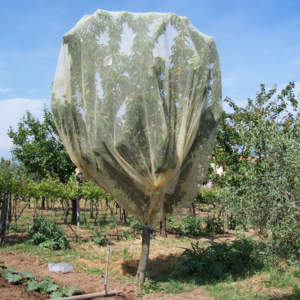
- Welcome Predators – Generalist predators like birds will eat Japanese beetles. Check out our Chirp, Chirp, Hurray! factsheet to learn how to encourage native birds to visit your backyard.
- Keep Plants Healthy – Unhealthy plants are more susceptible to defoliation. Keep your trees, shrubs and other plants healthy and more resilient against defoliation with regular care. Consistent monitored watering, compost and mulch helps reduce stress and encourage healthy, new growth if defoliation occurs.
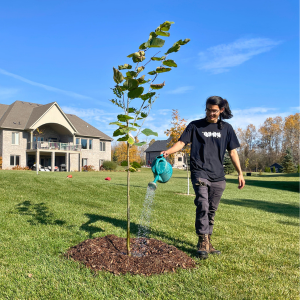
For management tips to reduce the impact of Japanese beetle grub larvae, visit the Invasive Species Centre.
Japanese beetles are here to stay but the good news is that they don’t have to spoil your summer! Awareness, monitoring and keeping your backyard trees, shrubs and other plants in good health help reduce their impact, so that you can enjoy your sunny summer days.
Jess Wilkin is the Residential Planting Programs Operations Supervisor and an ISA certified arborist at LEAF.
LEAF offers a subsidized Backyard Tree Planting Program for private property. The program is supported by the City of Toronto, the Regional Municipality of York, the City of Markham, the Town of Newmarket, the City of Vaughan, the Regional Municipality of Durham, the Town of Ajax, the Municipality of Clarington, the City of Oshawa, the City of Pickering, the Township of Scugog, the Town of Whitby and Ontario Power Generation.
